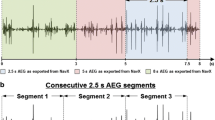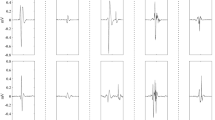Abstract
A recently developed algorithm that is based on symbolic dynamics and computation of the normalized algorithmic complexity (Cα) was applied to basket-catheter mapping of the atrial fibrillation (AF). The aim of our study was to analyze the spatial distribution of the Cα during AF and effects of propafenone on this distribution. During right atrial mapping in 25 patients with AF 31 intra-atrial and 1 surface bipolar channels were acquired. The anatomical location of the intra-atrial electrodes was defined fluoroscopically. Cα was calculated for a moving window (size: 2000 points; step 500 points). Generated Cα was analyzed within 10 minutes before and after administration of propafenone. The inter-regional Cα distribution was analyzed using the Friedman-test (intra-individually) and Kruskall-Wallis-H-test (inter- individually). A value of p=0.05 was set for an error probability. Inter-regional Cα differences were found in all patients (p<0.001). The right atrium could be divided in high- and low complexity areas according to individual patterns. A significant Cα increase in cranio-caudal direction (with the exception of septum) was confirmed inter-individually (p<0.01). The administration of propafenone enlarged the areas of low complexity.
Conclusions: This new method utilizing the combination of symbolic dynamics and adaptive power estimation can provide complex evaluation of the dynamics of AF in man. High-density mapping will be required for further evaluation of results.
Similar content being viewed by others
References
Rogers JM, Bayly PV, Ideker RE, et al. Quantitative techniques for analyzing high resolution cardiacmapping data. IEEE-Engineering in Medicine and Biology Magazine 1998;17:63-71.
Berkowitsch A, Erdogan A, Neuzner J, et al. New non linear approach to a quantitative assessment of atrial fibrillation mapping. Medical & Biological Engineering & Computing 1999;37 (Suppl 2):398-399.
Schuster H. Information content of chaotic signals. Physica Scripta, 1989;40:367-372.
Wackenbauer R, Witt A, Atmanspacher H, et al. A comparative classification of complexity measures. Chaos, Solutions & Fractals 1994;4:133-173.
Schack B, Grieszbach G. Adaptive Methods of Trend Detection and their Application in Analyzing Biosignals. Biom. J 1994;36:429-452.
Baresova E, Grieszbach G, Schack B, et al. Filtering properties of an adaptive trend operator and the application for determining the atrial blood velocity in retinal vessels. Medical progress through technology 1996;21:123-134.
Hoyer D, Grieszbach G, Witte H, et al. Adaptive preprocessing of evoked potentials. Biomedizinische Technik, 1990;35:263-270.
Hoekstra BPT, Cees MS, Diks GH, et al. Nonlinear analysis of epicardial atrial electrograms of electrically induced atrial fibrillation in man. J Cardiovasc Electrophysiol 1995;6:419-440.
Lempel A, Ziv J. On the complexity of finite sequences. IEEE Trans Inform Theory 1976;22:75-88.
Kuths J, Schwarz U, Witt A, et al. Measures of Complexity in Signal Analysis. In R. Katz, Chaotic, Fractal, and Nonlinear Signal Processing, 3rd Techn. Conf. on Nonlinear Dynamics and Full Spectrum Processing 10-14.07.94 Mystic, CT. AIP, Conference Proceedings 375, Woodbury, New York, 1996:33-54.
Grieszbach G, Schack B, Putsche P, et al. Dynamic description of stochastic signal by adaptive momentary power and momentary frequency estimation and its application of biological signals. Med Biol Eng Comp 1994;32:632-637.
Scaglione M, Riccardi R, Lambetti F, et al. FF interval analysis:reproducibility in different epochs of atrial fibrillation. Arch Mal Coeur Vas 1998;(special III):338.
Pitschner HF, Berkovic A, Grumbrecht S, et al. Multielectrode basket catheter mapping for human atrial fibrillation. J Cardiovasc Electrophysiol, 1998;9 (Suppl.):48-56.
Gaita F, Riccardi R, Calo L, et al. Atrial mapping and radiofrequency catheter ablation in patients with idiopathic atrial fibrillation. Electrophysiological findings and ablation results. Circulation 1998;97:2136-2145.
Kuck KH, Ernst S, Capatto R, et al. Nonfluoroscopic endocardial catheter mapping on atrial fibrillation. J Cardiovasc Electrophysiol, 1998;9(Suppl.):57-62.
Kumagai K, Yasuda T, Nougouchi H, et al. Regional difference in organization of atrial activity in the right atrium during atrial fibrillation Arch Mal Coeur Vas 1998;91 (special III):339.
Saksena S, Giorgberidze I, Mehra R, et al. Electrophysiology and endocardial mapping of induced atrial fibrillation in patients with spontaneous atrial fibrillation. Am J Cardiol 1999;83:187-193.
Adam M, Fischetti D, Montenero AS. A typical pattern of activation in the right atrium during paroxysmal atrial fibrillation:the washing-machine phenomenon Cardiologia 1999;44:63-68.
Capucci A, Villani GQ, Aschieri D, et al. Safety of oral propafenone in the conversion of recent onset atrial fibrillation to sinus rhythm:a prospective parallel placebo-controlled multicentre study Int J Cardiol 1999;68:187-196.
Kochiadakis GE, Igoumenidis NE, Parthenakis FI, et al. Amiodarone versus propafenone for conversion of chronic atrial fibrillation:results of a randomized, controlled study J Am Coll Cardiol 1999;33:966-971.
Ciolli A, De Sisti A, Montenero AS, et al. Idiopathic atrial fibrillation of recent onset and atrial stunning: the echocardiographic evidence after pharmacological cardioversion. Cardiologia 1998;43:1077-1082.
Ergene U, Ergene O, Cete Y, et al. Predictors of success in the conversion of new-onset atrial fibrillation using oral propafenone. Eur J Emerg Med 1998;5:425-428.
Reimold SC, Maisel WH, Antman EM, Propafenone for the treatment of supraventricular tachycardia and atrial fibrillation:a meta-analysis. Am J Cardiol 1998;82 (8A):66-71.
Boriani G, Biffi M, Capucci A, et al. Conversion of recent-onset atrial fibrillation to sinus rhythm:effects of different drug protocols. PACE 1998;21:2470-2474.
Wang Z, Page P, Nattel S. Mechanism of flecainide's antiarrhythmic action in experimental atrial fibrillation. Circ Res 1992;71:271-287.
Wang Z, Pelletier LC, Talajic M, et al. Effects of flecainide and quinidin on human atrial action potentials; role of rate-dependence and comparison with guinea pig, rabbit, and dog tissues. Circulation 1990;82:274-283.
Wang J, Bourne GW, Wang Z et al. Comparative mechanisms of antiarrhythmic drug action in experimental atrial fibrillation:the importance of use-dependent effects on refractoriness. Circulation 1993;88:1030-1044
Author information
Authors and Affiliations
Rights and permissions
About this article
Cite this article
Berkowitsch, A., Carlsson, J., Erdogan, A. et al. Electrophysiological Heterogeneity of Atrial Fibrillation and Local Effect of Propafenone in the Human Right Atrium: Analysis Based on Symbolic Dynamics. J Interv Card Electrophysiol 4, 383–394 (2000). https://doi.org/10.1023/A:1009846232715
Issue Date:
DOI: https://doi.org/10.1023/A:1009846232715




